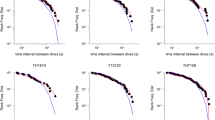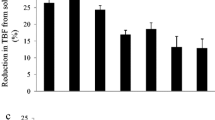Abstract
Scyphomedusae are ubiquitous in marine and estuarine systems, where they frequently play an important role in trophodynamics. Many scyphomedusae are cruising predators, and feeding rates depend, in part, on swimming behavior. Yet, no model of medusa swimming exists. An individual-based correlated random walk (CRW) model of medusa swimming behavior in three dimensions was developed. The model was validated using a previously published dataset of the swimming of 19 Chrysaora quinquecirrha (Desor, 1848) medusae that were observed in the presence or absence of zooplankton prey in laboratory mesocosms in August–October 1998 (Matanoski et al. in Mar Biol 139:191–200, 2001). In the presence of prey, medusae swam at a constant moderate rate in looping trajectories. In the absence of prey, medusae alternated periods of slow and fast swimming in more linear trajectories. In the model, looping trajectories were reproduced only when changes in movement by a medusa were oriented to its current position and orientation; more linear trajectories were reproduced by movement oriented to a fixed framework. This suggests that medusae change from swimming behavior oriented to local stimuli (e.g., contact with prey) to long-range stimuli (e.g., gravity) depending on the availability of prey. The model reproduced cyclical changes in swimming speeds by medusae in the absence of prey by simulating switching in the behavior controlling the strength of swimming bell pulsations using a probabilistic function. Model results also demonstrated that medusae tend to swim toward the surface, avoid contact with the bottom, increase time spent in prey patches if they alter swimming patterns in the presence of prey, and exhibit significant periodicities in swimming patterns that are the result of deterministic behavior. The model will permit the simulation of the complex behavior of medusae.







Similar content being viewed by others
References
Arai MN (1991) Attraction of Aurelia and Aequorea to prey. Hydrobiologia 216/217:363–366
Arai MN (1997) A functional biology of Scyphozoa. Chapman& Hall, New York
Austin D, Bowen WD, McMillan JI (2004) Intraspecific variation in movement patterns: modeling individual behaviour in a large marine predator. Oikos 105:15–30
Batschelet E (1981) Circular statistics in biology. Academic, New York
Bidigare RR, Biggs DC (1980) The role of sulfate exclusion in buoyancy maintenance by siphonophores and other oceanic gelatinous zooplankton. Comp Biochem Physiol 66A:467–471
Brown CW, Hood RR, Li Z, Decker MB, Gross TF, Purcell JE, Wang HV (2002) Forecasting system predicts presence of sea nettles in Chesapeake Bay. EOS 83(30):321, 325–326
Bundy MH, Gross TF, Coughlin DJ, Strickler JR (1993) Quantifying copepod searching efficiency using swimming pattern and perceptive ability. Bull Mar Sci 53:15–28
Buskey EJ (1984) Swimming pattern as an indicator of the roles of copepod sensory systems in the recoginition of food. Mar Biol 79:165–175
Costello JH, Colin SP (1994) Morphology, fluid motion, and predation by the scyphomedusa Aurelia aurita. Mar Biol 121:327–334
Costello JH, Colin SP (1995) Flow and feeding by swimming scyphomedusae. Mar Biol 124:399–406
Costello JH, Klos E, Ford MD (1998) In situ time budgets of the scyphomedusae Aurelia aurita, Cyanea sp., and Chrysaora quinquecirrha. J Plank Res 20:383–391
Coughlin DJ, Strickler JR, Sanderson B (1992) Swimming and search behavior in clownfish, Amphiprion perideraion, larvae. Anim Behav 44:427–440
Cowan JH Jr, Houde ED (1992) Size-dependent predation on marine fish larvae by Ctenophores, Scyphomedusae, and Planktivorous fish. Fish Oceanog 1:113–126
DeAngelis DL, Gross LG (1992) Individual-based models and approaches in ecology. Chapman and Hall, New York
DeAngelis DL, Petersen JH (2001) Importance of the predator’s ecological neighborhood in modeling predation on migrating prey. Oikos 94:315–325
Dixon AFG (1959) An experimental study of the searching behaviour of the predatory coccinellid beetle Adalia decempunctata (L.). J Anim Ecol 28:259–281
Dutkiewicz S, Griffa A, Olson DB (1993) Particle diffusion in a meandering jet. J Geophys Res 98:16487–16500
Ford MD, Costello JH, Heidelberg KB, Purcell JE (1997) Swimming and feeding by the scyphomedusa Chrysaora quinquecirrha. Mar Biol 129:355–362
Gerritsen J, Strickler JR (1977) Encounter probabilities and community structure in zooplankton: a mathematical model. J Fish Res Board Can 34:73–82
Gladfelter WB (1972) Structure and function of the locomotory system of the scyphomedusa Cyanea capillata. Mar Biol 14:150–160
Graham WM, Pages F, Hamner WM (2001) A physical context for gelatinous zooplankton aggregations: a review. Hydrobiologia 451 (Dev Hydrobiol 155):199–212
Grunbaum D (1998) Using spatially explicit models to characterize foraging performance in heterogeneous landscapes. Am Nat 151:97–115
Hamner WM, Hauri IR (1981) Long-distance horizontal migrations of zooplankton (Scyphomedusae: Mastigias). Limnol Oceanogr 26:414–423
Hamner WM, Gilmer RW, Hamner PP (1982) The physical, chemical, and biological characteristics of a stratified, saline, sulfide lake in Palau. Limnol Oceanogr 27:896–909
Hamner WM, Hamner PP, Strand SW (1994) Sun-compass migration by Aurelia aurita (Scyphozoa): population retention and reproduction in Saanich Inlet, British Columbia. Mar Biol 119:347–356
Haury LR, McGowan JA, Wiebe PH (1978) Patterns and processes in the time-space scales of plankton distributions. In: Steele JH (ed) Spatial pattern in plankton communities. Plenum Press, New York, pp 277–327
Hinckley S, Hermann AJ, Megrey BA (1996) Developmment of a spatially explicit, individual-based model of marine fish early life history. Mar Ecol Prog Ser 139:47–68
Hindley JPR (1975) The detection, location and recognition of food by juvenile banana prawns, Penaeus merquiensis (de Man). Mar Behav Physiol 3:193–210
Holton J (1992) An introduction to dynamic meteorology. Academic, San Diego
Hood RR, Wang HV, Purcell JE, Houde ED Jr. LWH (1999) Modeling particles and pelagic organisms in Chesapeake Bay: convergent features control plankton distributions. J Geophys Res 104:1223–1243
Huston M, DeAngelis D, Post W (1988) New computer models unify ecological theory. Bioscience 38:682–691
Johnson DR, Perry HM, Burke WD (2001) Developing jellyfish strategy hypotheses using circulation models. Hydrobiologia 451 (Dev Hydrobiol 155):213–221
Kareiva P (1982) Experimental and mathematical analyses of herbivore movement: quantifying the influence of plant spacing and quality on foraging discrimination. Ecol Monogr 52:261–282
Kareiva PM, Shigesada N (1983) Analyzing insect movement as a correlated random walk. Oecologia 56:234–238
Keister JE, Houde ED, Breitburg DL (2000) Effects of bottom-layer hypoxia on abundances and depth distributions of organisms in Patuxent River, Chesapeake Bay. Mar Ecol Prog Ser 205:43–59
Leising Aw, Franks PJS (2000) Copepod vertical distribution within a spatially variable food source: a simple foraging-strategy model. J Plank Res 22:999–1024
Letcher BH, Rice JA, Crowder LB, Rose KA (1996) Variability in survival of larval fish: disentangling components with a generalized individual-based model. Can J Fish Aquat Sci 53:787–801
Levin SA (1978) Pattern formation in ecological communities. In: Steele JH (ed) Spatial pattern in plankton communities. Plenum Press, New York, pp 433–466
Mackie GO, Larson RJ, Larson KS, Passano LM (1981) Swimming and vertical migration of Aurelia aurita (L) in a deep tank. Mar Behav Physiol 7:321–329
Madin LP (1988) Feeding behavior of tentaculate predators: in situ observations and a conceptual model. Bull Mar Sci 43:413–429
Malej A (1989) Behaviour and trophic ecology of the jellyfish Pelagia noctiluca (Forsskal, 1775). J Exp Mar Biol Ecol 126:259–270
Manning A, Dawkins MS (1998) An introduction to animal behaviour. Cambridge University Press, New York
Marsh LM, Jones RE (1988) The form and consequences of random walk movement models. J Theor Biol 133:113–131
Matanoski JC, Hood RR, Purcell JE (2001) Characterizing the effects of prey on the swimming of the scyphozoan Chrysaora quinquecirrha and implications for feeding efficiency. Mar Biol 139:191–200
Matanoski JC, Hood RR, Owens RL, Purcell JE (2004) Patterns in swimming by a scyphomedusa: a novel approach to quantifying behavior in individuals. Mar Biol 145:303–313
Mills CE (1981) Diversity of swimming behaviors in hydromedusae as related to feeding and utilization of space. Mar Biol 64:185–189
Okubo A (1980) Diffusion and ecological problems: mathematical models. Springer, Berlin Heidelberg New York
Okubo A, Levin SA (2002) Diffusion and ecological problems: modern perspectives. Springer, Berlin Heidelberg New York
Purcell JE (1992) Effects of predation by the scyphomedusan Chrysaora quinquecirrha on zooplankton populations in Chesapeake Bay, USA. Mar Ecol Prog Ser 87:65–76
Purcell JE, Brown ED, Stokesbury KDE, Haldorson LH, Shirley TC (2000) Aggregations of the jellyfish Aurelia labiata: abundance, distribution, association with age-0 walleye pollock, and behaviors promoting aggregation in Prince William Sound, Alaska, USA. Mar Ecol Prog Ser 195:145–158
Rice AL (1964) Observations on the effects of changes of hydrostatic pressure on the behaviour of some marine animals. J Mar Biol Assoc UK 44:163–175
Rice JA, Miller TJ, Rose KA, Crowder LB, Marschall EA, Trebitz AS, DeAngelis DL (1993) Growth rate variation and larval survival: inferences from an individual-based size-dependent predation model. Can J Fish Aquat Sci 50:133–142
Root RB, Kareiva PM (1984) The search for resources by cabbage butterflies (Pieris rapae): ecological consequences and adaptive significance of markovian movements in a patchy environment. Ecology 65:147–165
Rose KA, Cowan JH (1993) Individual-based model of young-of-the-year striped bass population dynamics. I. Model description and baseline simulations. Trans Am Fish Soc 122:415–438
Scheibe TD, Richmond MC (2002) Fish individual-based numerical simulator (FINS): a particle-based model of juvenile salmonid movement and dissolved gas exposure history in the Columbia River basin. Ecol Modell 147:233–252
Schuyler D, Sullivan BK (1997) Light responses and diel migration of the scyphomedusa Chrysaora quinquecirrha in mesocosms. J Plankton Res 19:1417–1428
Shanks AL, Graham WM (1987) Orientated swimming in the jellyfish Stomolopus meleagris L. Agassiz (Scyphozoan: Rhizostomida). J Exp Mar Biol Ecol 108:159–169
Skalski GT, Gilliam JF (2000) Modeling diffusive spread in heterogeneous populations: a movement study with stream fish. Ecology 81:1685–1700
Smith JNM (1974) The food searching behaviour of two European thrushes. II: the adaptiveness of the search patterns. Behaviour 49:1–61
Smith KL Jr, Baldwin RJ (1982) Scavenging deep-sea amphipods: effects of food odor on oxygen consumption and a proposed metabolic strategy. Mar Biol 68:287–298
Sokal RR, Rohlf FJ (1995) Biometry. W.H. Freeman and Company, New York
Steele JH (1978) Some comments on plankton patches. In: Steele JH (ed) Spatial pattern in plankton communities. Plenum Press, New York, pp 1–20
Strand SW, Hamner WM (1988) Predatory behavior of Phacellophora camtschatica and size-selective predation upon Aurelia aurita (Scyphozoa: Cnidaria) in Saanich Inlet, British Columbia. Mar Biol 99:409–414
Tittensor DP, Deyoung B, Tang CL (2003) Modelling the distribution, sustainability and diapause emergence timing of the copepod Calanus finmarchicus in the Labrador Sea. Fish Ocean 12:299–316
Turchin P (1991) Translating foraging movements in heterogeneous environments into the spatial distribution of foragers. Ecology 72:1253–1266
Turchin P (1998) Quantitative analysis of movement measuring and modeling population redistribution in animals and plants. Sinauer Associates, Sunderland
Wright DA, Purcell JE (1997) Effect of salinity on ionic shifts in mesohaline scyphomedusae, Chrysaora quinquecirrha. Biol Bull 192:332–339
Zar JH (1984) Biostatistical analysis. Prentice Hall, Englewood Cliffs
Zavodnik D (1987) Spatial aggregations of the swarming jellyfish Pelagia noctiluca (Scyphozoa). Mar Biol 94:265–269
Zollner PA, Lima SL (1999) Search strategies for landscape-level interpatch movements. Ecology 80:1019–1030
Acknowledgements
An earlier draft of this paper benefited greatly from suggestions made by M. Christman, E. Houde, and J. Purcell and three anonymous reviewers. The authors particularly wish to express their gratitude to V. Coles for guidance regarding coordinate systems. This research was supported in part by Horn Point Laboratory Education Committee funding awarded to J. Matanoski and National Science Foundation support awarded to R. Hood (OCE-9628888). All experiments were conducted in the USA, and were in compliance with current law. This paper represents UMCES Contribution No. 3919.
Author information
Authors and Affiliations
Corresponding author
Additional information
Communicated by J.P. Grassle, New Brunswick
Rights and permissions
About this article
Cite this article
Matanoski, J.C., Hood, R.R. An individual-based numerical model of medusa swimming behavior. Mar Biol 149, 595–608 (2006). https://doi.org/10.1007/s00227-006-0244-1
Received:
Accepted:
Published:
Issue Date:
DOI: https://doi.org/10.1007/s00227-006-0244-1




